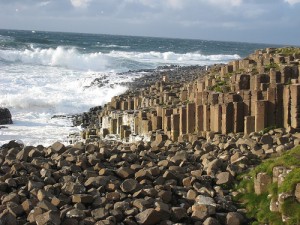Northern Ireland
 Northern Ireland (also known as Ulster) is located on the island of Ireland and is part of the United Kingdom. Despite its reputation of being a violent place, the political situation has stabilized and it’s safe to travel here. Northern Ireland offers a variety of things to see and do: from stunning landscapes to vibrant cities and historical landmarks.
Northern Ireland (also known as Ulster) is located on the island of Ireland and is part of the United Kingdom. Despite its reputation of being a violent place, the political situation has stabilized and it’s safe to travel here. Northern Ireland offers a variety of things to see and do: from stunning landscapes to vibrant cities and historical landmarks.
Location
Northern Ireland is located in the north east part of the island of Ireland. To the south and west , it shares a border with the Republic of Ireland.
Regions
Northern Ireland comprises six counties of Ulster, which was one of the four ancient Irish provinces:
- County Antrim: home to Belfast, Giant’s Causeway and the North Coast
- County Armagh
- County Londonderry
- County Down: home to the coastal resort of Bangor and the Mourne Mountains
- County Fermanagh: home to numerous lakes
- County Tyrone: home to the Sperrin Mountains
How to get to
By air
Belfast International Airport (BFS) is the most important international gateway into Northern Ireland. Aside from the domestic flights , it also receives flights from various large European airports and from the USA. Some of the airlines operating here are: Aer Lingus, bmibaby, Continental Airlines, easyJet , Jet2 and WizzAir.
George Best Belfast City Airport (BHD) receives only flights from the UK (domestic) and Ireland; while City of Derry Airport (LDY) receives flights from the UK, Republic of Ireland and from some other European airports.
By train
Northern Ireland has a rather good rail network although the service has been cut back and there’s a lack of investment. There are four domestic lines and there’s also the Enterprise line which is jointly operated by Northern Ireland Railways and Iarnród Éireann.
By car
Belfast is the center of the road network. Although there are only three motorways in Northern Ireland, the other roads are very well maintained. There are good connections both within Northern Ireland and to the Republic of Ireland.
By boat
There are frequent ferries across the Irish Sea, which connect Northern Ireland to Great Britain.
The following operators offer services:
- Stena Line : from the Port of Belfast to Stranraer (Scotland) ; from Larne to Fleetwood (near Liverpool)
- P&O Irish Sea Ferries: from Larne to Troon (Scotland)
Weather
Northern Ireland has a temperate maritime climate and is wetter in the west than in the east. Although the seasons are distinct, they are less pronounced than in the rest of Europe and the weather is unpredictable year round.
Some temperatures
Belfast
January avg high 7C / avg low 4C
July avg high 17C / avg low 13C
Larne
January avg high 7C / avg low 3C
July avg high 17C / avg low 12C
Londonderry
January avg high 10C / avg low NA
July avg high 18C / avg low 10C
>>read more about Weather in Ireland
Things to do
Most of the tourist sites are concentrated in Belfast . Make sure to visit Saint Anne’s Cathedral , Belfast Castle Botanical Gardens, Ulster Museum, Belfast Zoo and St. George’s Market.
If you want some adventure, than make sure to head to the Mourne Mountains. They are a walker’s paradise , where trails take you past rivers, lakes and woodland. It is also possible to rock climb.
Rent a car and head to Causeway Coast (the North Coast). It offers some of the best scenery in Europe. The rugged coastline meets some romantic landscape along the way , not to mention the waterfalls, the castles and the interesting ruins you will encounter. Giant’s Causeway is located here as well, with its hexagonal basalt columns and tales of ancient Irish giants.